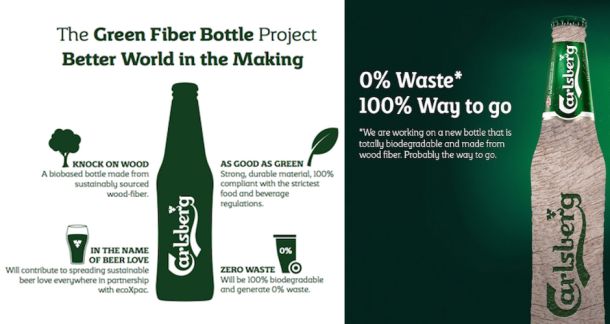Carlsberg is working on a bottle made from moulded fibre in an effort to reduce the greenhouse gas emissions produced from packaging.
Carlsberg Foundation chairman, Professor Flemming Besenbacher, presented a prototype at the World Economic Forum in January and said he hoped it would launch within three years.
The bottle is part of ongoing Corporate Social Responsibility (CSR) efforts within Carlsberg, with technology to manufacture the bottles developed by Danish company ecoXpac. The company is now part of a development group with the Danish Technological Institute and Carlsberg.
Carlsberg's Simon Hoffmeyer Boas has been working to establish the concept of sustainable packaging within the group for the past nine years because, he says, 45 per cent of its total greenhouse gas emissions come from packaging.
“It’s important we take this issue seriously,” he told Bo Wallteg of Sweden’s nord emballage.
“We’re in a vulnerable world with limited resources, and believe that in the future we'll see a lot of new ways of working. One example is to avoid the use of fossil fuels.”
He says packaging is a big part of the Carlsberg brand, and when it is improperly handled by the consumer it is negative for the environment and the brand.
“Obviously it’s not our intention to say to the consumer that just because it’s a fibre bottle they can throw it away anywhere,” Boas explains.
“On the contrary, we want to be very clear that this type of packaging must be disposed of properly once it's been used.”
The Green Fibre Bottle has been a project of ecoXpac since 2009. It can be manufactured in any size and the walls of the bottle are thicker than plastic alternatives, but overall the bottle is lighter. It can be made in any colour and given relief designs. The technology used makes it possible to scan any bottle and quickly produce a fibre copy. A large part of the development was finding a method for the fast and energy efficient removal of up to 80 per cent of the water content in the fibre after forming. This is now done using a vacuum.
The thread and seal on the bottle will be made of fibre in the final bottle, and the bottle will have an internal coating.
More to be done
There is still a lot of work to be done before the bottle reaches the market. During the next three years a variety of studies will be carried out, including studies of environmental profiles, markets, and consumers.

“It’s important that we optimise the bottle and make sure it’s in the right market with the right content and targeted at the right consumer group,” says Boas.
One possible problem with a fibre bottle is that it won’t be transparent.
“Obviously we've included this in our development work and realise that in some cases it may be something of a limitation, but once again it will depend hugely on which markets and products we focus on initially,” he says.
One important aspect of the development process is to achieve a production rate that allows the fibre bottles to be manufactured at about the same rate as plastic bottles. The actual filling of the bottles should take place on the regular bottling lines, with only minor adjustments.
“We will make resources available on one of our bottling lines for all test runs,” says Boas.
“And since we expect the fibre bottle to be quite similar to a glass or plastic bottle, there shouldn’t be any need for major changes.”
Here's a video that details the Green Fiber Bottle technology:







